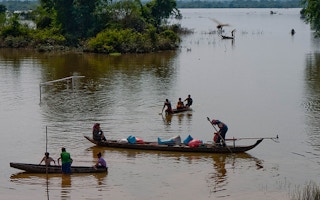Electricity rates are skyrocketing in Laos, just as the hot season tightens its grip on a country that aims to be the “battery” that powers Southeast Asia with hydropower from river dams.
Some people have watched as their rates for electricity have more than tripled, and they are scratching their heads as to why they are suddenly paying so much for power when Vientiane has been touting the country’s power generating ability as a way to bring Laos out of poverty.
“Over the past few months, my household paid only 80,000 kip (U.S. $9.80), but this month I am charged 250,000 kip (U.S. $31),” said a resident of Savannakhet province, who requested anonymity. “That surprises me.”
At first the Savannakhet dweller told RFA’s Lao Service that he thought he was the only one paying the high bills, but then he talked to his neighbors.
“I thought I was the only one over-charged, but my neighbors also have the same problems, and some of them brought their bills to Electricite Du Laos to ask about the high cost,” he said.
The Vientiane-based Electricite Du Laos is the state corporation that owns and operates the former French colony’s power generation, transmission, and distribution system.
Southeast Asia has been roasting in an extended heat wave with temperatures reaching unprecedented levels, allowing at least three countries to set new all-time national heat records and several others to come very close.
The heat wave has driven record energy consumption and prompted health warnings on everything from foodborne illness to drowning throughout the region.
Laos, Cambodia and Thailand set new all-time record highs for any day of the year during April, according to The Weather Channel, a U.S.-based network. In addition, Malaysia, Singapore and Vietnam have all come very close to setting new national heat records.
“
The majority of the income generated by electricity production will be in the hands of the investors, while dams in Laos are damaging a huge amount of natural resources.
Vientane resident
The new all-time record high for Cambodia was set on April 15 when the mercury soared to 108.7 degrees Fahrenheit (42.6 degrees Celsius) in Preah Vihear, beating the previous record set just two days earlier in Banteay Ampil, the Weather Channel Reported.
Who gets paid?
Record heat often pushes up the rates for electricity as demand outstrips supply, but Lao electricity customers wonder if there’s something more nefarious behind the price jump.
“I always hear that the government declares that Laos will become Asia’s battery, though the Lao government gets less of a percentage of revenue than the shareholders in each hydropower project,” said a resident of Vientiane who requested anonymity.
Laos and many other Asian countries are on a dam-building spree as they try to harness the power of the Mekong and other rivers. While the Lao government sees power generation as a way to bootstrap the country’s economy, the projects are still controversial for their environmental impact and their financial arrangements.
According to International Rivers, an environmental advocacy group, the current Lao hydropower development plan includes 72 new large dams, 12 of which are under construction and nearly 25 in advanced planning stages.
“There are many things Laos’ people do not know about the power projects, like how much income goes into Laos’ treasury and overseas investors’ pockets,” the Vientiane resident told RFA. “The majority of the income generated by electricity production will be in the hands of the investors, while dams in Laos are damaging a huge amount of natural resources.”
While the Lao government claims the dams will help pay for anti-poverty and other social welfare programs, International Rivers claims that much of the power generated by Laos is sold to neighboring countries and then resold to Laos at higher rates.
“Unfortunately for the Laotian people, the government has been importing the same hydro-generated power back from Thailand at an increased price,” International Rivers reported. “The companies and investors driving the current Lao hydro-boom hail from Thailand, China, Vietnam and Malaysia, though the World Bank, the Asian Development Bank, and companies from Japan, France and Norway remain on the scene.”
No real number
Phongsavath Kaisinh, a power company official in charge of billing, blamed the heat on the spike in demand that is driving prices up.
“Overcharges for use of electricity is normal because it is the hot season and people need to overuse the electricity in their houses,” Kaisinh said.
On 24 May, Electricite du Laos held a press conference to explain the reasons for an increase of the charge.
A reporter who attended the press conference but declined to be named told RFA that power company officials gave two reasons why prices have shot up, aside from the weather.
“The cost of electricity in Laos is low when compared with the other nine countries of ASEAN so it needs to be adjusted to be in line with the other countries, and the staff who record the statistics of electricity use in the households do not do so based on the real number – they estimate it,” the reporter said.
Copyright © 1998-2014, RFA. Used with the permission of Radio Free Asia, 2025 M St. NW, Suite 300, Washington DC 20036.

















